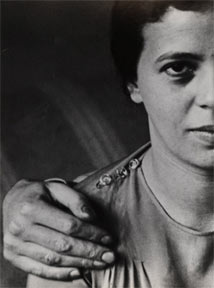Andre' Kertesz
dal 8/7/2005 al 20/8/2005
Segnalato da
8/7/2005
Andre' Kertesz
RoseGallery, Santa Monica
The exhibition of vintage photographs will combine the best of artist's work from Paris and New York. One of the first photographers to consciously explore the possibilities of the small format camera, he created mystery out of the familiar through a deliberate exploitation of the properties inherent to a portable photographic device. He had developed a method of combining immediate experience with rigorous formal structure to produce work characterized by its graphic intensity.

Hungarian-born André Kertész forged a seventy-year career as a master of street photography and photojournalism beginning in his native Budapest in 1912. One of the first photographers to consciously explore the possibilities of the small format camera, Kertész created mystery out of the familiar through a deliberate exploitation of the properties inherent to a portable photographic device. As early as 1920, Kertész had developed a method of combining immediate experience with rigorous formal structure to produce work characterized by its graphic intensity. His mastery of darkroom technique combined with a proclivity toward the uncommon angle, wherein composition, mood, and story flawlessly commingled, became a trademark of his legacy, and influenced such renowned photographers as Henri Cartier-Bresson, Lee Friedlander, and Robert Frank.
Techniques employed by Kertész from the age of seventeen evolved into a signature style of simplistic exactitude upon his relocation to the burgeoning cosmopolitan art world of Paris in 1925. His celebrations of modern Parisian life and culture often focused on the artistic luminaries who welcomed him; Chagall, Colette, Brancusi, and Mondrian among them. The visual poetry produced by Kertész was warmly embraced by fashionable publications and institutions throughout Europe including the Royal Photographic Society of Great Britain, and the Association Belge de Photographie in Brussels. His success in European galleries and museums catalyzed Kertész’s emigration to New York City in the mid 1930’s, and although he sought the same recognition in New York which had allowed him to prosper in Paris, the American response to his work was meager, and Kertész fell into relative obscurity for nearly forty years. Taken during decades of isolation, his New York pictures highlight Kertész’s perseverance as a relentless explorer of modernity and its indomitable forms. Their rediscovery in the 1970’s during the growth of the photographic art market reinstated Kertész to the status of a master photographer who had initiated the rise of street photography. His work continues to garner acclaim for its capacity to reveal intimate moments with an uncompromising sense of timing and design.
RoseGallery’s forthcoming exhibition of vintage photographs by André Kertész will combine the best of his work from Paris and New York, including prominent images of Washington Square Park taken in his later years. Kertész has been the subject of numerous publications including André Kertész, Observations, thoughts, reflections, and André Kertész, a monograph published in conjunction with the recently concluded 2005 retrospective at the National Gallery of Art in Washington, which will be presented by the Los Angeles County Museum of Art beginning in June, 2005.
Photographs by André Kertész will be on view at RoseGallery from 25 June to 20 August, 2005. An opening reception will be held on Saturday, 09 July, from 6-8.
Image: André Kertész, “Elizabeth and I, Parisâ€, 1931
RoseGallery
2525 Michigan Ave., G-5 (Bergamot Station), Santa Monica, CA 90404
Hours, Tuesday – Saturday, 10am-6pm



